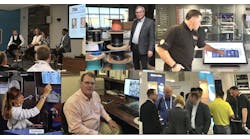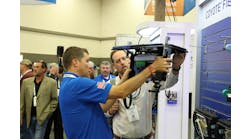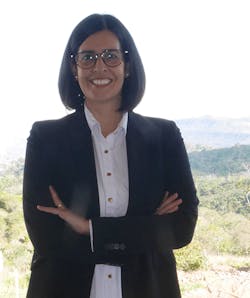Latest from Professional Development/Leadership
Executive Insights with Martha Suárez, President, Dynamic Spectrum Alliance
How Wi-Fi’s Global Future Can Help or Hinder Digital Inclusion
Topic: Priorities
ISE: What are two of DSA’s network-related priorities for 2022?
Martha Suárez, Dynamic Spectrum Alliance: To answer this question, it’s important to look at the advancements that were made in the last two years. There is a global momentum to enable the use of the entire 6 GHz band for Wi-Fi, which is crucial for broadband access. Governments worldwide have already opened the full 1200 MHz of the band for Wi-Fi access, including the USA, Republic of Korea, Saudi Arabia, Brazil and Canada. Wi-Fi plays a central role in connectivity worldwide, accounting for over half of total traffic (fixed and mobile) transferred over the Internet and generating enormous economic value. As the trend towards wireless connectivity continues to increase globally, Wi-Fi is crucial in our lives, providing wireless connectivity inside our homes and offices, as well as at public hotspots such as hotels, cafés and restaurants, airports, libraries, or hospitals.
The European Commission (EC) took an important first step towards meeting growing broadband demands, by opening the lower part of the 6 GHz band for Low Power Indoor and Very Low Power license-exempt operation. But that is not enough. The European decision to open 480 MHz in the 6 GHz band to Wi-Fi secures sufficient Wi-Fi spectrum only for the next two years. The Dynamic Spectrum Alliance aims to provide a constructive contribution to the debate about Europe’s 2030 Digital Targets, as we believe Europe has the opportunity to drive productivity, economic growth and societal development through the deployment of the next generations of Wi-Fi in the entire 6 GHz band. It is essential that the regulatory framework ensures that Europe can respond to the expected increased demand for Wi-Fi connectivity and unlocks the digital innovation enabled by this technology, in particular for start-ups and Small and Medium-sized Enterprises (SMEs), which are at the forefront of European digitalization.
In 2022, the DSA will be encouraging the EC and more broadly regulators all around the world to open the full 5925-7125 MHz band for Wi-Fi use. That is the only way to avoid a spectrum shortfall for Wi-Fi, that according to studies of the Wi-Fi Alliance (WFA), will be of up to 1.6 GHz in the mid-frequency range by 2025, limiting the performance and availability of Wi-Fi, and limiting the digital innovative ecosystem that involves new use cases like augmented and virtual reality (AR/VR), directly impacting both residential and corporate networks.
The DSA will continue to provide accurate and technical information to spectrum decision makers. For example, in early February, DSA’s letter to the Minister for Communications, Urban Infrastructure, Cities and the Arts of Australia, presented a policy white paper explaining that Wi-Fi in the 6 GHz band is necessary to enable the next generation of Wi-Fi Gigabit technologies, Wi-Fi 6E and Wi-Fi 7, and to thrive alongside other technologies like satellite, 5G and fiber. We expect to see more consultation on this subject, mainly from regulators in Asia-Pacific, Africa and the Middle East.
Another priority of the DSA will be to encourage spectrum authorities to make more spectrum available on a shared or lightly-licensed basis by implementing automated dynamic shared access technology, which is readily available from multiple commercial providers and can greatly facilitate access by a wide variety of users. There is no question that today we have the technical ability to automate frequency coordination, which leads to lower transaction costs, more efficient use of spectrum, faster time-to-market for new services, protection of incumbents from interference with greater certainty, and expansion of the supply of wireless connectivity that is fast becoming, like electricity, a critical input for most other industries and economic activity. The introduction of new licensing options supported by automated dynamic spectrum sharing technology is the best path to support such deployments.
Topic: Wi-Fi 6E
ISE: Wi-Fi 6E operates on the 6 GHz band so that no legacy devices can access it. Wi-Fi 6E devices will be able to work on Wi-Fi 6 and other previous standards, but no devices without 6E support will be able to access the superhighway. From a capacity standpoint, it’ll have access to 59 non-overlapping channels, so places like sports arenas, concert halls, and other high-density environments will provide much more capacity with less interference. Please share your thoughts about this. Talk about the challenges/solutions related to additional spectrum needed to meet Wi-Fi demands.
Suárez: Wide channels deliver the high-bandwidth content users demand while maintaining the ability to share spectrum with other license-exempt transmitters. They increase spectrum efficiency and deliver high-bandwidth applications and services, like those in high-density environments such as sports arenas and concert halls. Lack of wider channels create a detrimental impact on real-time voice and video services, and high-bandwidth immersive services such as AR/VR will be starved of sufficient capacity. Wi-Fi 6E enables the use of multiple 160 MHz wide channels that cannot be implemented on existing 2.4 GHz and 5 GHz spectrum allocations, which are too fragmented, and which were allocated in an era of now-outmoded generations of RLAN technology.
In addition to home and office networking, Wi-Fi is essential for cellular offload and location applications, and global trends in technology and equipment are making Wi-Fi a central pillar of global initiatives to expand connectivity to underserved communities and boost economic growth. Given this growth and the evolution to Wi-Fi 6E and Wi-Fi 7, there is an urgent need to consider making the full 1200 MHz in the 6 GHz band available on a license-exempt basis.
Topic: The Future
ISE: What emerging or disruptive technology excites you the most for the ICT industry? Why?
Suárez: Spectrum sharing is the overarching technology that excites me most for the ICT industry. As the potential of Wi-Fi 6E and 5G emerges, this is how new applications will develop, and how underserved populations will have their connectivity needs met.
While Internet demand and usage surges, spectrum is a finite source. It is not a material that we can just find more of or dig up out of the ground, which means we must find new ways to make our usage more efficient, in ways that allow for innovative technologies. The foundation of which is based in legislature and regulation.
TV White Spaces are unused broadcasting frequencies, and TVWS technology is increasingly empowering smaller ISPs to provide cost-effective broadband in underserved regions. Research shows that wireless technologies take longer for underserved populations to adopt, so this wireless means of providing broadband is an effective way of bridging the digital divide. For ISPs, TVWS technology allows operators to use low-frequency signals that propagate through geographical obstructions like buildings and vegetation. This results in increased non-line-of-sight coverage, at an affordable price.
Citizens Broadband Radio Service (CBRS) is also a spectrum sharing technology endorsed by the DSA, it is a spectrum sharing success story in its own rights. The FCC has designated the 3550-3700 MHz band of spectrum for sharing among three tiers of users: incumbent users, priority licensees and generally authorized, which is lightly licensed. It enables the most efficient and intensive use of mid-band spectrum that’s critical for 4G and 5G. Using data base and location identification technologies protects incumbent services (mainly satellite ground stations and military applications), while licensed access and general access provide opportunities for large and small entities to promote greater deployment.
Of course, the DSA supports unlicensed access to the 6 GHz band in order to meet the demand for Wi-Fi and unlicensed wireless devices. The future of the band is exciting, because it unlocks new emerging and disruptive applications in the ICT industry, such as advanced AR/VR, holographic or haptic systems. With more governments and regulators seemingly acknowledging the potential of this band for unlicensed access, I hope we will continue to see it allocated for Wi-Fi over the next year and beyond.
Topic: Your Take
ISE: Share one problem/challenge you are passionate about solving for the ICT Industry.
Suárez: Despite the mass digital transformation and technical innovation in many parts of the world, almost 40% of our global population is still unconnected. More than ever, the pandemic highlighted the necessity of reliable Internet access, as people continued to work, socialize, and learn from the safety of their homes.
Initially, many people thought underdevelopment was the cause of the digital divide, and that with the popularization of technology, it would gradually close. But this has proved untrue, the divide persists, and in fact is more prevalent than ever. Digitalization requires costly investment, so rural and poorer regions face far more roadblocks than wealthier, urban areas. Even where technology is available, digital literacy isolates many people from fully utilizing the resources they have; according to the ITU in 2019, in 40 out of 84 countries, less than half the population had basic computer skills, including the ability to copy a file or send an email with an attachment.
The DSA is passionate about addressing this gap for underserved communities, creating a large ecosystem with many providers and flexible frameworks for effective and dynamic Internet access. Too often, spectrum is seen as a tool divided between licensed and unlicensed access. By viewing spectrum as a naturally shared resource, protecting incumbent services and considering costs and other benefits, an appropriate spectrum sharing criteria is developed which facilitates the efficient use of spectrum. Providing connectivity to those who need it and strengthening communication methods already in place for the benefit of underserved communities worldwide, is of top priority for the DSA.
Topic: The “Next” Is Now
ISE: According to one of the DSA white papers, “Expanding spectrum availability for license-exempt technologies will help governments everywhere address improvements in broadband access for their populations and help close the digital divide.” How are different countries preparing to ensure there is enough bandwidth available to meet the demands of Industry 4.0, 5G, and VR and AR?
Suárez: As I’ve briefly mentioned, many countries globally have already started to open the 6 GHz spectrum band for Wi-Fi use on a license-exempt basis. Wi-Fi is key to the digitalization across society (public services, SMEs, industries, etc.). Thanks to its low cost, easy deployment, and enhanced performance, they will also support the widespread adoption of new digital applications and services that will enhance the productivity of industrial plants, enterprise campuses and other business facilities in a variety of domains. Ensuring enough spectrum for Wi-Fi, is the right decision to meet the demands of Industry 4.0, boosting innovation, unlocking the emergence of the future generation of devices and applications, such as advanced AR/VR, holographic or haptic systems. Wi-Fi also complements and thereby boosts innovative applications based on other networks (such as 5G, 6G, satellite or fiber).
USA’s Federal Communications Commission (FCC) was the first to open the entire band, in a watershed moment for connectivity and innovation. In the two years since then, regulators and governments globally have been recognizing the possibilities that come with license exempt use of the whole band—Canada, Brazil, Saudi Arabia, South Korea, and Chile are just a few of the countries which have taken this step. Furthermore, the industry has also been very engaged in delivering chipsets, devices and applications. We recently saw that Broadcom, one of the DSA members, has shipped one billion Wi-Fi 6/6E radios. Moreover, according to the information publicly available at the WFA website, by January 2022 there were more than 60 Wi-Fi 6E certified access points, as well as many smartphones, tablets and computers available in the market.
In Australia, the Australian Mobile Telecommunication Association (AMTA) released its “Policy Position Paper” on spectrum for 5G services. It highlighted the need for spectrum to address the increasing reliance on mobile bands to support connectivity. But almost every device that connects to a cellular network relies on Wi-Fi in some way to connect devices in the home or workplace, so while there is a need for denser cellular networks, this increasing demand will also increase traffic on the Wi-Fi networks that are the final link to user devices. Allocating the 1200 MHz of spectrum to Wi-Fi is an opportunity Australia really cannot afford to miss.
While Europe has opened the lower part of the band for Wi-Fi, the story here is similar, without the upper part of the band there will not be enough spectrum for Wi-Fi 7 that will need channels of 320 MHz of bandwidth. Several countries in Europe, namely Croatia, Czech Republic, Cyprus, Denmark, Ireland, Lithuania, and Slovakia, have supported the CEPT to start coexistence studies between wireless access systems such as Wi-Fi, and incumbent users in the upper part of the 6 GHz band. Attending that request at the 57th ECC Plenary, it has approved a new work item in this direction.
Finally, the DSA is currently working with the UK Governments Digital Access Programme towards better digital inclusivity in Brazil, Indonesia, Kenya, Nigeria and South Africa. The collaboration hopes to enable a pivotal change in the conversation about spectrum management, leveraging the respective networks of stakeholder relationships focused on the shared goal of inclusive connectivity.
Topic: Earth-Friendly Network
ISE: The Internet’s data may be invisible, but it requires physical data centers across the world that must be powered on, cooled, and protected 24 hours a day, seven days a week. Similarly, the magic of 5G is impossible without base stations that can consume a lot of energy. For businesses committed to Environmental, Social and Governance (ESG) goals, reducing their carbon footprint will be key in achieving company-wide emissions targets. Share two of your favorite earth-friendly, network-related strategies CSPs should embrace to help the ICT industry do more for the environment.
Suárez: DSA is convinced that Wi-Fi 6E and Wi-Fi 7 will contribute to a green transition, providing improved efficiency and enabling reduction of CO2 emissions in other sectors. For example, remote working and learning, and telemedicine can drastically reduce traffic and greenhouse gas emissions. Furthermore, a combination of fiber and Wi-Fi 6E/7 is also the greenest solution for indoor connectivity. Wi-Fi antennas for indoor use are low power with limited coverage since the area they need to transmit to is limited. This means they save energy in comparison to 5G base stations which must produce a much stronger and wide-reaching signal.
Topic: STEM Longevity
ISE: According to CNBC, there are three reasons why women don’t STAY in STEM careers: confidence, lack of mentorship and understanding their salary. Share your thoughts about how that should change.
Suárez: While studying for my Master’s degree, I had female role models who inspired me. In such a male-dominated field, I was lucky enough to have two women as advisors for my PhD; one was an expert in signal treatment, and the other an expert in radio frequencies. I’ll never know to exactly what end having strong female role models impacted my wider career, but especially at the beginning, they were excellent mentors and a great inspiration to me. This instilled a confidence that saw me go on to become Director General of ANE in Colombia, and of course President of the Dynamic Spectrum Alliance.
If lack of mentorship is a core reason that women leave STEM careers, it is up to those of us with experience in the field to offer this mentorship and stability for those starting out. Last year, I was very pleased to be part of a great project organized by the International Telecommunication Union (ITU) in the Americas Region and EQUALS, through the ITU Academy. The online course “Women’s leadership in the telecommunications and ICT sector” had two components: a technical one that I delivered, and a leadership part provided by Colombian women’s empowerment speaker, Paola Rueda Lopez. The main objective of the course was to reduce the gender gap in the sector, providing the main concepts in a clear and simple way, with an overview of industry trends and emerging technologies. In addition to this, I have been involved in other activities promoting more girls and women in ICT. This is my personal experience, but I notice that more and more women in leadership positions are actively promoting other women to grow and accelerate their careers.
Having more women in STEM is not just important for gender equality, but also for different perspectives and approaches in our work. For example, while it’s important for women to continue their careers and assume leadership roles, we must work on solutions for women’s digital inclusion. This is something that an entirely male dominated leadership may not have the firsthand experience to fully appreciate.
Topic: Listening and Learning
ISE: What podcasts do you recommend for others who want to grow into a leadership position?
Suárez: The Broadband Conversations podcast highlights women in leadership roles in the technology and telecommunications sector. The podcast is hosted by Jessica Rosenworcel, who the DSA was so pleased to see become the first woman chair of the FCC in October of last year. Her story is an inspiration to young women and girls in STEM who want to grow into a leadership position, so I would recommend her podcast.
FCBA Unplugged is hosted by Kelly Donohue, co-chair of the FCBA’s Membership and Marketing Committee. For anyone that doesn’t know, FCBA is a volunteer organization made up of people in law, dedicated to studying development, interpretation and practice of communications and information technology law and policy. To have a strong female lead on this podcast offers a fantastic role model to women and girls who might be interested in the legal side of telecommunications, and hopefully will give them the confidence and some knowledge to rise to a leadership position throughout their career.
Follow the DSA on:
LinkedIn: https://www.linkedin.com/company/dynamic-spectrum-alliance-limited/
Facebook: https://www.facebook.com/DynamicSpectrumAlliance
Twitter: https://twitter.com/DynamicSpectrum

Sharon Vollman | Content Ambassador for ISE EXPO
Sharon Vollman is the Content Ambassador for ISE EXPO. She is passionate about collaborating with thought leaders, SMEs and hard-working doers who design, plan and deploy ultra-reliable broadband networks. Vollman is committed to creating a variety of educational offerings for ISE EXPO attendees that inspire them to connect every U.S. citizen with the broadband networks we all want for our children and grandchildren.
Vollman has created educational partnerships with Broadband Service Providers including AT&T, Verizon, Lumen, Frontier Communications and others. She has covered the telecom industry since 1996.






